High-Tech Home Defense?
Tom McHale 10.08.18
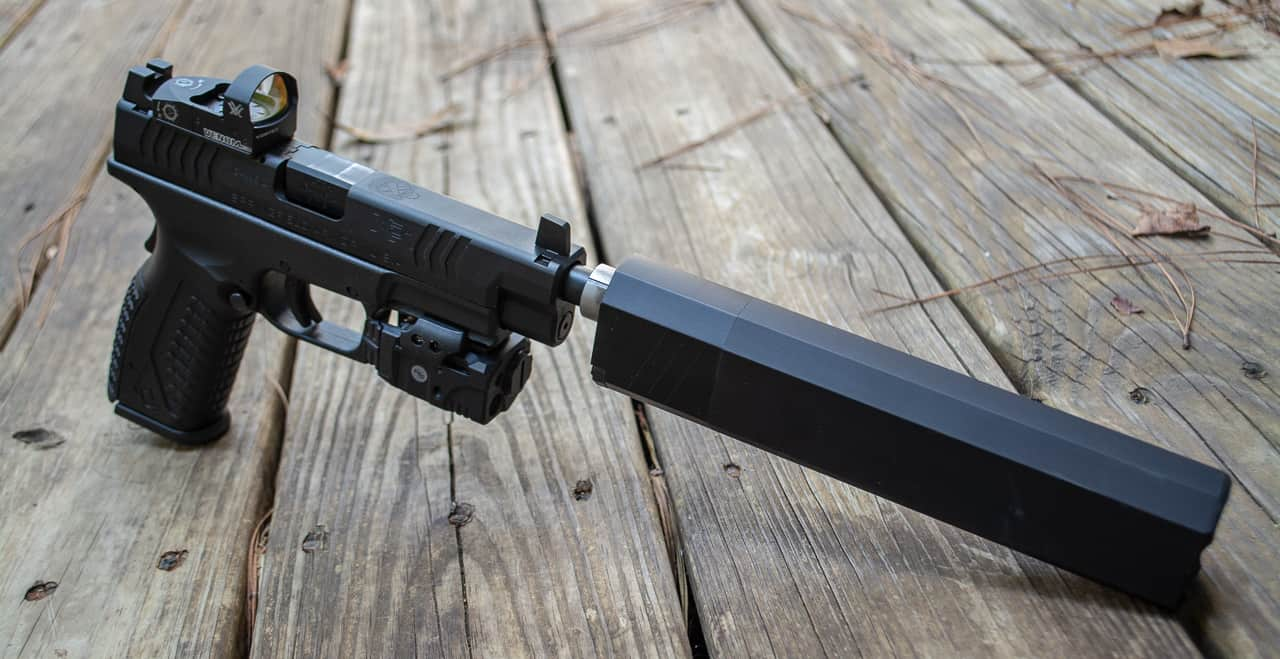
Tinkering around with a new gun and some sweet accessories has got me thinking about high-tech home defense pistols. I’ve been testing out the new Springfield Armory XD(M) OSP Threaded model with all of its associated bells and whistles to explore the concept. As for sweet accessories, I’ve added a Crimson Trace Railmaster Pro and SilencerCo Osprey 45 Suppressor to complement the Vortex Venom red dot sight already included.
The Springfield Armory XD(M) OSP Threaded is a full-size 9mm XD(M) with a few twists. Like its standard model sibling, it packs big capacity, with the two included magazines holding 19 rounds each. Having (20) 9mm cartridges at your beck and call during an emergency is nothing to sneeze at, even if you are a big-bore .45 ACP aficionado. Besides, if you are, perhaps the folks at Springfield Armory will make a future model with a larger orifice at the fiery end.
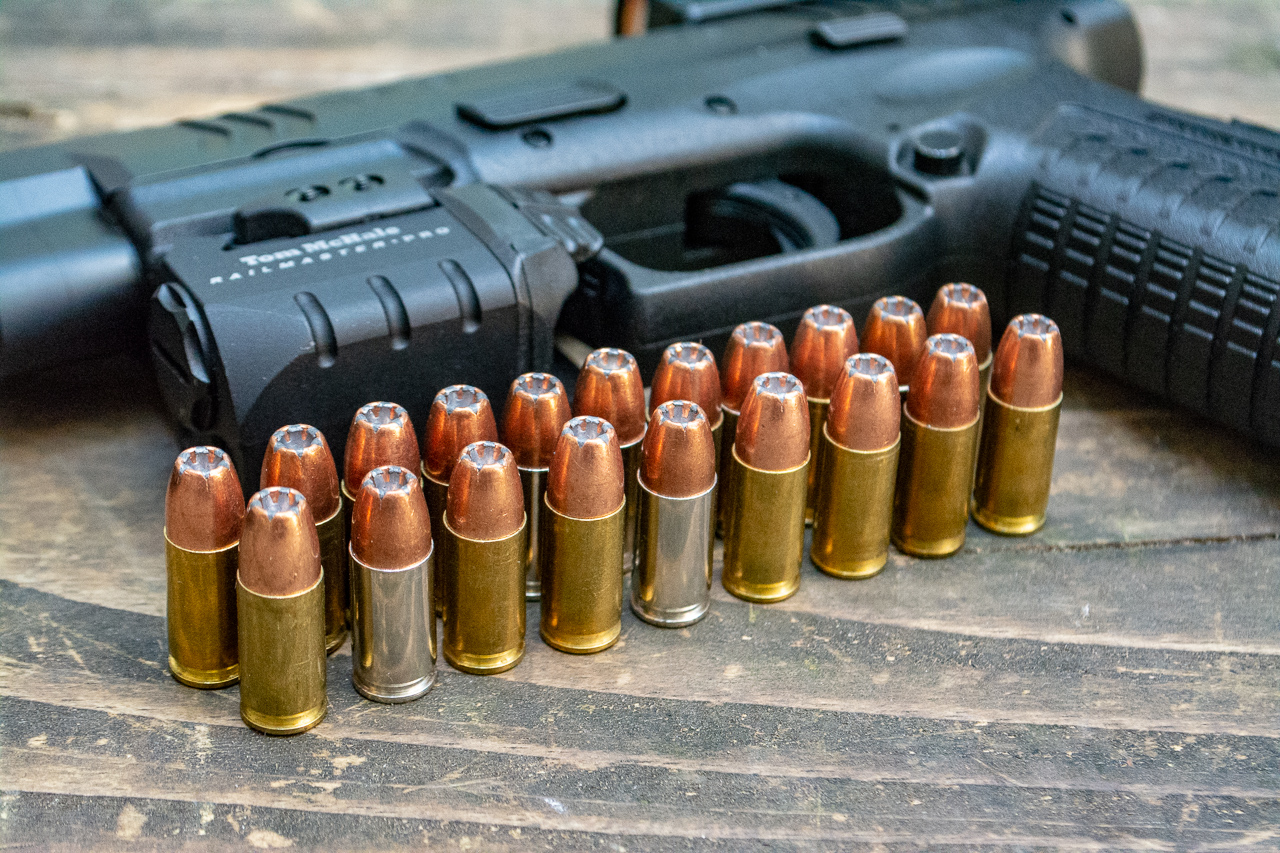
The twists on this model are that is supports integrated red dot sights and a suppressor. Because suppressor bodies tend to obstruct your view through standard sights, the taller profile of a red dot offers a great sighting solution when shooting in quiet mode. Of course, red dots have other pros and cons too. We’ll get into those in a minute. So, given the suppressor-friendly benefit of the red dot, the Springfield Armory team also added a threaded barrel and suppressor-height sights to this model. If the red dot goes down, you can still see the iron sights through the glass. To keep things simple, company ships the XD(M) OSP Threaded with a Vortex Venom red dot optic already installed. If you want to use your own, you can order a model without the sight included for a little less money.
So given all the potential accessories you can mount on a pistol like this one, does going “high-tech” with your home-defense pistol make sense? Let’s explore the topic.
Weapon Light
I’m a big fan of light. Not only does it help you from bumping into furniture in the dark, but it can also aid you in making instantaneous life and death decisions. While not a substitute for a hand-held flashlight to be used for searching, a weapon light allows you to obtain absolute and positive target verification just before you press the trigger. A weapon-mounted light also provides sighting assistance in low light conditions. Even though the lens is forward of both the front and rear sight, it still helps illuminate the sight picture. Try it.
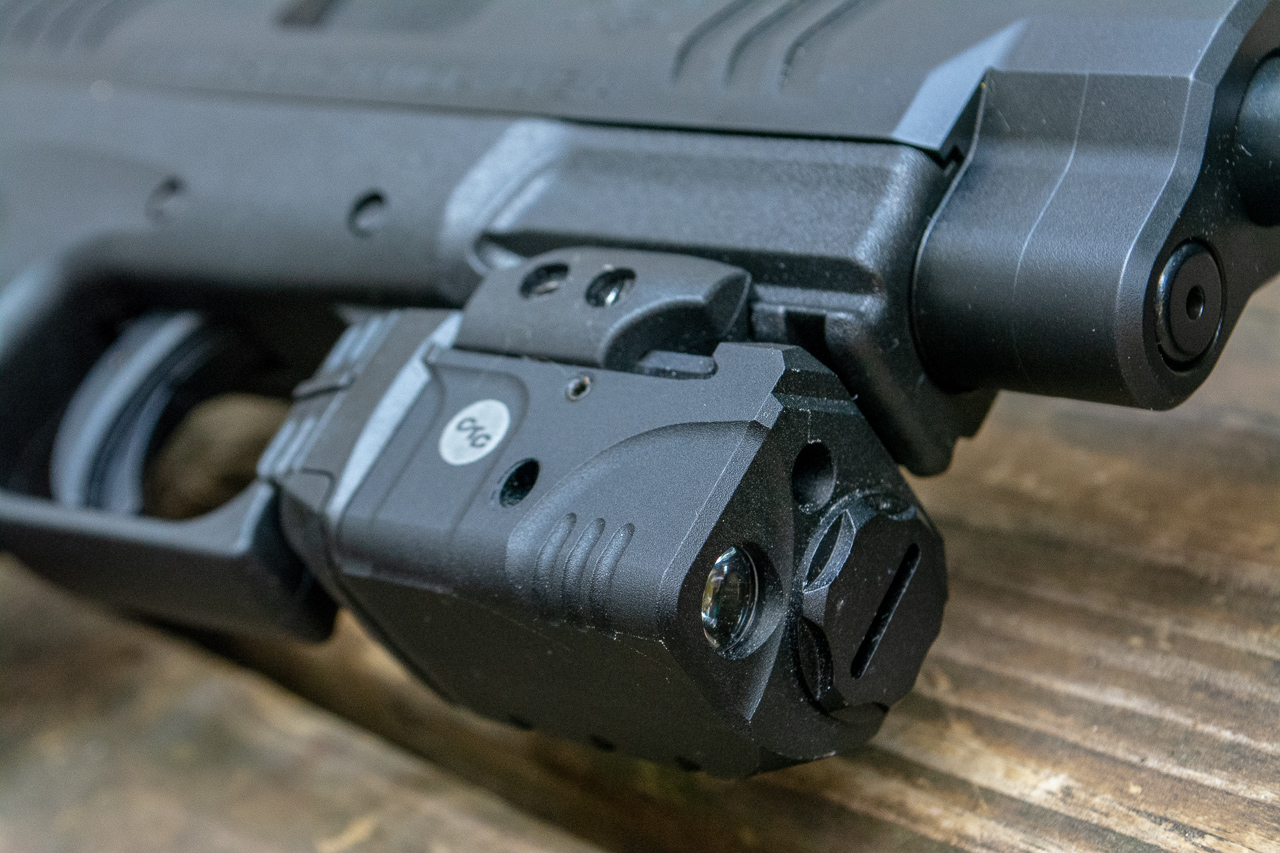
Of course, the other benefit to a weapon-mounted light is that you don’t have to worry about handling a separate light while shooting. Both hands can be used for handling the gun.
Laser
Can we address the elephant in the room proactively? That would be the oft-repeated phrase, “a laser will only give away your position!” If your job is to sneak around in the dark and kick down doors in an offensive capacity, I would agree with you. If your goal is to get shots on target as quickly and accurately as possible when surprised (and at a distinct defensive disadvantage) in the middle of the night, I would disagree.
If your home-defense strategy involves you sneaking around in a cat and mouse game playing ninja games with invaders where you’re worried about seeing each other’s laser dots, you’re doing it wrong. If you have to use a home defense gun, you’re already, by definition, behind the eight ball as you’re responding to an attack that someone else has planned. Getting shots on target quickly and accurately from this “behind the power curve” situation outweighs any “giving away your position” disadvantages in the vast majority of situations. Guess what? Your position is already known by virtue of the fact that someone invaded your home. It’s not as if you were hiding in a closet bunker awaiting an attack. Oh, and the other thing that will give away my position is my yelling something like, “Get the &*^% out of my house, I’ve already called 911!”
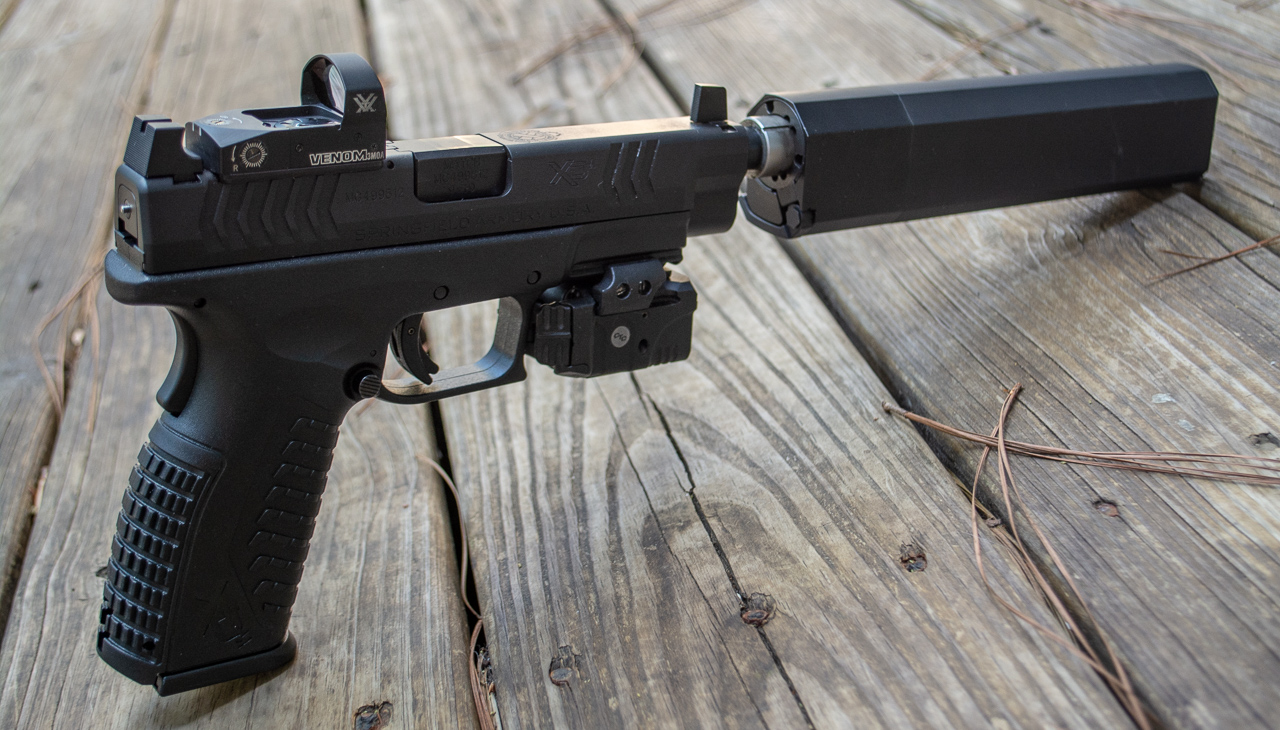
OK. Rant over. Now consider the benefits that a laser provides. It supports the natural human tendency to focus on the threat at hand. The dot is literally on your attacker. It doesn’t get simpler than that. It allows faster and more accurate sighting in low-light and dark conditions. Don’t take your laser to the range in the daylight and make a judgment that it’s slower than iron sights. That’s not what it’s for. A laser also allows you to shoot well from less conventional positions, like those you might find yourself in while protecting a child, fighting off an attacker, or shooting around an obstacle.
These are my opinions and I’m sticking to them. Your mileage may vary.
Red Dot Sight
Red dots are an interesting solution for pistol sighting. I tend to think that we’ll see a lot more of them on handguns going forward. Like putting scopes on rifles back in the day, there’s a lot of resistance to changing away from iron sights as the de-facto sighting solution. Time will tell, but in my testing, I’ve found that I am faster and more accurate at distances past ten yards. At shorter ranges, my overall speed of getting shots on target is about the same as with iron sights. But that’s just me.
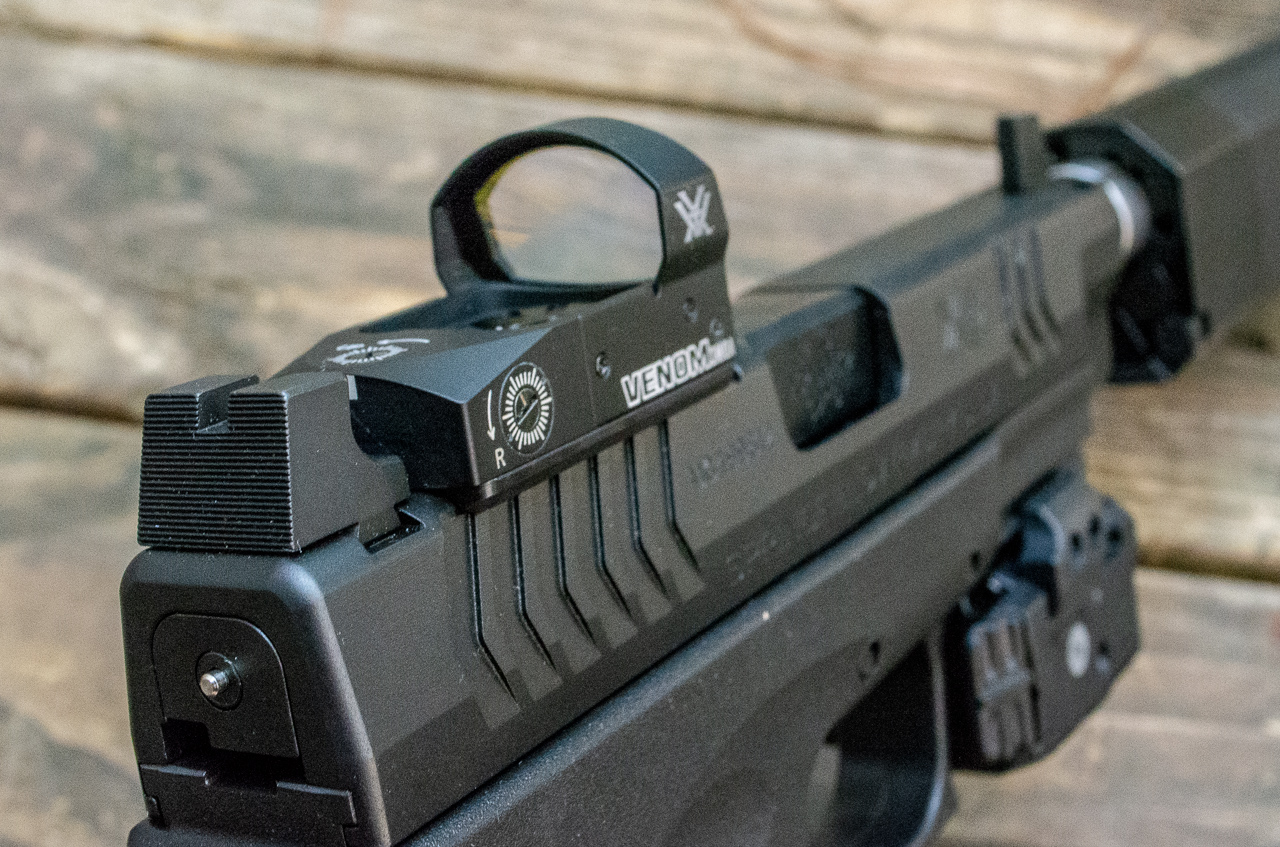
As with lasers, a red dot sight allows your eyes and brain to focus on the threat. The red dot appears on the target itself, so you don’t have to force yourself to fight against your natural instinct to align the rear sight, front sight, and target. There’s a reason that the fastest action pistol competitors use red dot sighting. Whether that will translate to home defense or concealed carry use remains to be seen.
There’s one more feature consideration for using a red dot sight for home defense. Will the dot be on when you need it? The Vortex Venom has two methods of operation. You can set it to an automatic time-out mode where it powers off after a period of inactivity. You’ll then need to re-enable it using one of the side buttons to turn it back on. For home-defense or carry use, this is a no-go for me. I want the dot on all the time, so I don’t have to think about adding a step. That’s OK, because the other operating mode of the Venom is always on. If you keep the power level in the lower half of the spectrum, the battery will last months or years. Since receiving this model a couple of weeks ago, I’ve done just that to make sure the plan works. So far, so good. As a side note, for indoor use, the lower brightness settings are best anyway since you’re not dealing with direct sunlight and a need for the red dot to overpower that type of glare.
Since we’ve talked about a red dot and a laser on the same gun, I should point out an observation. It sounds like a complex sighting solution: which sight picture do you use and how do you make that determination under stress? I’ve found the sighting choice to be self-selecting for the most part. Whatever my eye sees first, I just instinctively use. If it’s bright, like at an outdoor range, my eye sees red dots (or iron sights) naturally. In lower light conditions, the laser dot literally leaps into view, and that’s what my eye goes with.
Suppressor
On paper, a suppressed home-defense gun makes a lot of sense. If you haven’t torched off a handgun round (much less one from a rifle) indoors, then you’re in for a rude awakening. It’s loud. Since the interior space of a house or apartment is generally smaller than that of an indoor shooting range, count on the blast and concussion to be even louder and potentially disorienting. So, using that logic, a suppressor can make a big difference.
However, in life or death struggles, plenty of people don’t hear or recognize sounds not deemed by the brain vital to immediate survival. Auditory exclusion is a real thing. While the physics still exist, and hearing may be damaged, you may or may not be aware of all that noise commotion at the time.
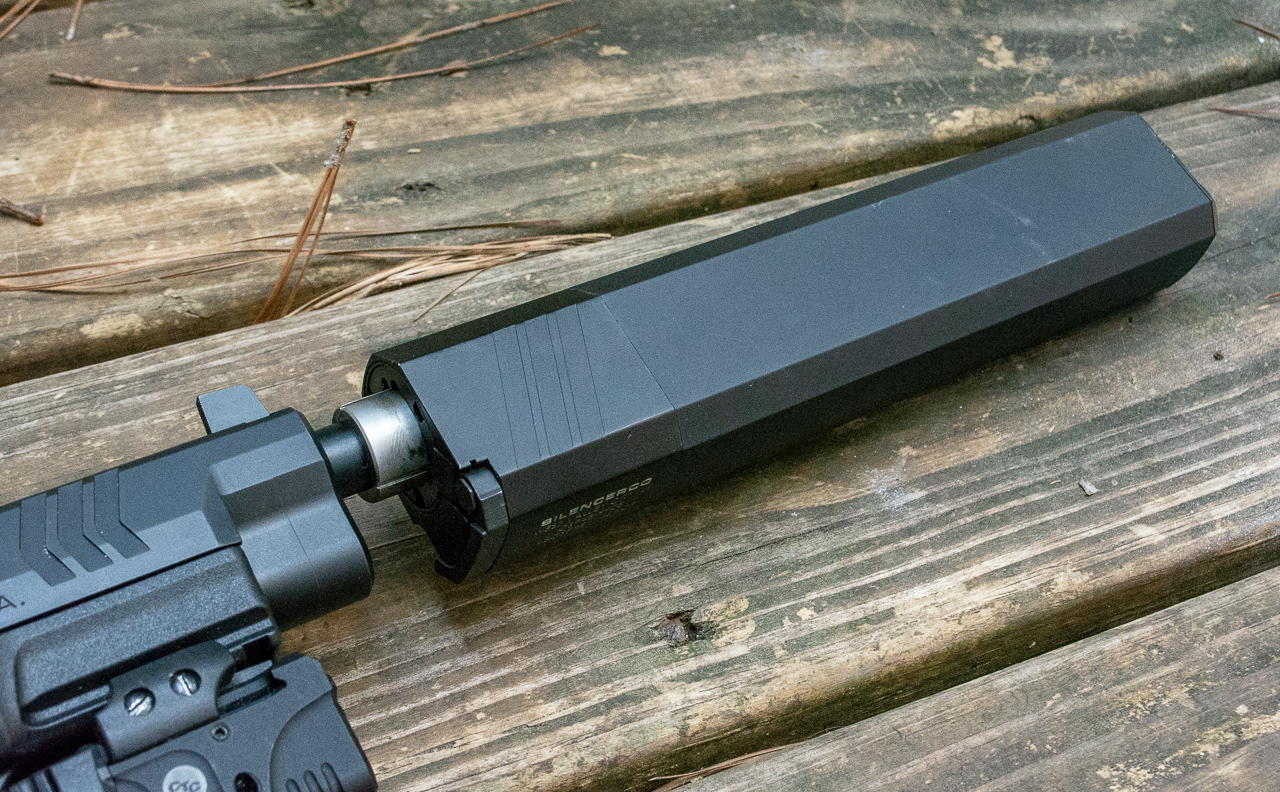
The other thing to consider is that adding a suppressor starts to negate some of the size and portability advantages of a handgun. For example, the SilencerCo Osprey 45 adds about 8 ½ inches to the overall length of the Springfield Armory XD(M) OSP Threaded pistol shown here. Yes, the 45 suppressor is a hair longer than the 9mm version, but you’re still adding a good bit of bulk even with a dedicated 9mm silencer. Weight isn’t a huge factor as I find I can shoot this pistol just fine with one or two hands. Does the extra length really matter? That’s probably a personal preference issue. It doesn’t bother me too much, but your opinion may vary.
There is a slight benefit to shooting suppressed in that recoil and muzzle flip are dramatically mellowed out. While it’s not a muzzle brake, it does accomplish some of the same results. Felt recoil is almost always less than without and a pistol is easier to control. Take that for what it’s worth.
My net-net opinion on the suppressor. It can be a “nice to have” feature on a home-defense gun, but it’s not in the same “must have” category as a light and laser in my book.
The Bottom Line
So what’s the verdict? The light? Check. While I also keep a flashlight handy for looking, I want a light on my home-defense pistol. There’s no good reason not to have one mounted. Laser? Also yes. Using a laser doesn’t remove any capabilities you had before, it adds to your repertoire. Red dot sight? They’re growing on me the more I use them, maybe even for concealed carry. We’ll call the red dot a “maybe” for now. As for the suppressor, it clearly falls into the “why not” but also the “it won’t ruin my day if it’s not there” bucket.

